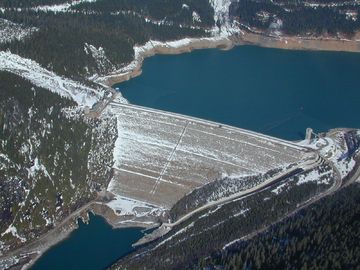Hydropower

Hydropower is the overall power that can be harnessed from water and its flows. It is the overall summation of the potential energy and kinetic energy that the water has. The potential energy of water is usually referred to as its hydraulic head. In hydroelectric generation, this hydraulic head represents a height difference between the reservoir and the outflow channel or tail race. Generally speaking this hydraulic head is any height difference in a water flow. The kinetic energy of the water is related to the velocity of moving water and the volume of water being moved, also known as the flow rate.[2]
With special technologies, hydropower can be harnessed by humans and used for electricity generation. The electricity generated from this process is known as hydroelectricity. Humans have been harnessing hydropower for millennia. The ancient Greeks used water wheels to grind wheat over 2000 years ago.[3] Hydropower continued to be exclusively converted directly into mechanical power up until the end of the 19th century when electrical dynamos where attached to the shaft to generate electricity.[4]
The energy of moving water is purely mechanical energy, one of the highest-quality forms of energy. So in theory, since it is such a high-quality energy it can be converted to electrical energy with near 100% efficiency since there is no thermal energy involved (and thus thermodynamics doesn't have to be taken into account). However, there are still minor losses associated with friction and inefficiencies in the transportation of electricity (as a result of factors such as resistance in wires). Overall, this means hydropower can be converted to electricity with efficiencies higher than 90%.[5]
Energy in Water
The potential and kinetic energy of water varies as it moves through some body, such as a river. If some sort of device is used to harness this energy - such as a hydro turbine - this kinetic and potential energy can be transformed into a type of energy that can be used.
Potential Energy of Water
The potential energy of water is the energy the water obtains as a result of being at some elevation. Put simply, the head difference of water is what results in potential energy. The relationship for the power from the potential energy of water can be expressed as:[6]
where:
= power in watts (W)
= density of water in kilograms per cubic meter (kg/m3)
= flow rate of the water in cubic meters per second (m3/s)
= acceleration due to gravity in meters per second squared (m/s2)
= height difference between two points of the water flow in meters (m)
This expression is known as the hydroelectric power equation. The height difference between inlet and outlet in conventional generation is generally created by damming a river to create a reservoir. Water from the reservoir is then directed through turbines which convert the energy in in fluid into electrical energy. The amount of energy that can be converted is related to the efficiency of the turbine and electrical generator.
Kinetic Energy of Water
The kinetic energy of the water is a result of the speed of the flow of the water. The relationship for the power from kinetic energy of water is proportional to this velocity and can be expressed as:[6]
where:
= power in watts (W)
= density of water in kilograms per cubic meter (k/m3)
= cross-sectional area of the flow in square meters (m2)
= velocity of the fluid in meters per second (m/s)
The result of the cubic relationship is that a flow with twice the velocity of a reference will have eight times the kinetic energy. This fact has a large influence on the placement of potential hydroelectric generators.
References
- ↑ Wikimedia Commons. (September 2, 2015). Mica Dam [Online]. Available: http://en.wikipedia.org/wiki/File:MicaDam.JPG
- ↑ Engineering Toolbox. (September 2, 2015). Hydropower [Online]. Available: http://www.engineeringtoolbox.com/hydropower-d_1359.html
- ↑ IEA. (September 2, 2015). What is hydropower’s history? [Online]. Available: http://www.ieahydro.org/What_is_hydropower’s_history.html
- ↑ Water Power Program: History of Hydropower. (n.d.). Retrieved from http://www1.eere.energy.gov/water/hydro_history.html
- ↑ R. Wolfson. Energy, Environment and Climate, 2nd ed. New York, U.S.A.: Norton, 2012
- ↑ 6.0 6.1 Vishul Suresh. (September 2, 2015). Physics of Hydropower [Online]. Available: http://www.academia.edu/8701598/Physics_of_Hydropower

